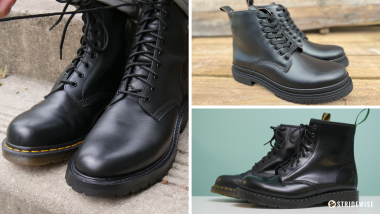Why Are There So Many Great Indonesian Boots? An Interview With Santalum
A lot of people like their formal clothing handmade in Italy or France, but many guys who have swung by Bangkok or Hoi An to pick up a tailor-made suit have trouble telling the difference. The same goes for boots, but finding the right shoemaker can be a little tougher for men with discerning tastes. The leather needs to be the right quality, comfort is paramount, and of course, nobody can make a Goodyear welt by hand, right?
Enter Indonesia, Asia’s unofficial headquarters for fine
For 149 years the region was known as the Dutch East Indies, a period during which The Netherlands ruled over the islands largely in order to profit from their spices, cash crops, and strategic shipping routes. The colonizers brought with them a love of durable leather footwear that resulted in an unusual Asian boot economy centered in the West Javan capital of Bandung, Indonesia’s third most populous city. At the turn of the 19th century, the Dutch established a shoe factory on Cibaduyut Road, and as time passed and more and more shoemakers used the skills they learned from the Dutch to branch out and found their own companies, Bandung became Asia’s unofficial boot capital.
If you’ve ever wanted a pair of high quality, tailor-made, Goodyear welted boots but don’t want to pay European prices, it’s worth reaching out to one of the well known boot companies in the area like Sagara, Jalan Sriwijaya, Winson, Txture, Junkard, or Santalum.
Stridewise sat down with Laurensius Mahendriyo, the owner of Santalum, to learn more about the pitfalls and benefits of manufacturing boots in the Indonesian tropics.
Stridewise: So how did you decide to start a boot company in such a crowded space?
Laurensius Mahendriyo: I founded it in 2010 with my friend Ratnu, and it actually started with denim — we noticed the popularity of denim and realized that denim has complementary goods that are made from leather, which we started exploring. We started making shoes, but ultimately decided that boots were more interesting due to the construction, the shape, and the styles we could explore. Then we learned to make them and that’s how we started Santalum. We focus on traditional construction like the Goodyear welt and we strive to get the best quality leather, especially in Indonesia.
SW: Does the leather come from Indonesia?
We mostly use Horween leather from the United States while we try to bring Indonesian leather to the same level of quality. So it’s a learning curve that we’re working on right now. We’re searching for the best quality leather until we can find leather that matches the quality of Horween.
SW: What are some of the biggest challenges that come with making boots in Indonesia compared to somewhere like the United States?
The number one challenge we face right now is finding craftsmen. Our head shoemaker is almost 70 years old, and Ratnu and I have learned that the skill required to make our boots takes at least five years to learn. So the two of us are still learning while we also try to pass the knowledge on to younger people. We know we can keep producing for the next five or ten years, but we’re always looking for the right person to carry the craft to the next generation.
[See my review of Santalum’s Mile 85 boot here!]
SW: What are some of the upsides of being located in Indonesia?
The skill and the labor costs less than in America, so our shoes can be the same quality as you’ll find in American or European stores for cheaper.
SW: How long does it take to make a pair of Santalum boots?
In one month, we only produce twenty pairs. In a week we make only four pairs of boots, since the process takes 2 to 3 days .
We really don’t use the machinery you find in big shoe manufacturers, like stitching machines and cutting machines for the upper. We cut everything by hand. The Goodyear welt is done by hand.
SW: You make Goodyear welts by hand?
Yes. We actually made a video about it.
[Related: The 8 Best Indonesian Boot Brands]
SW: Would you say you draw more inspiration from European or American designs?
In our boots, I think I’d say American. But we also develop some dress shoes that are more influenced by European style shoes.
SW: Where are most Indonesian boots sold, do many of them go overseas?
Actually right now, 80 percent goes to America or worldwide.
SW: What’s your most popular boot?
We have a lot of customers buy on our Service boot, which they say is very similar to the Viberg service boots.
SW: What shoemaker do you most admire?
I really like the Japanese style boots, particularly from a brand called White Kloud. I really like their style and construction, and we’re more or less inspired by them in terms of the shape of shoe last and their quality.
Further Reading

The 5 Best Japanese Boot Brands
We met up with experts to find the best Japanese boot brands on the market. Learn more →
SW: OK, we’ll check them out! Thanks for taking the time to chat, Laurensius.
Featured image via @sanatalum_id on Instagram. For custom orders, email Santalum at [email protected].










Nick,
I have given up looking for comfortable boots, they are all to narrow so I am looking at getting a boot onto the market. Your thoughts?
Get a wider shoe! Most companies have wider fits, everyone from Viberg to Thursday to Red Wing. You can find a pair for you, Ross! If you need like EEE widths I think Alden or Dayton are great, but there are cheaper options.